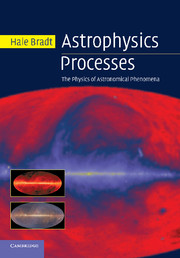Book contents
- Frontmatter
- Contents
- List of figures
- List of tables
- Preface
- Acknowledgments
- Also by the author
- 1 Kepler, Newton, and the mass function
- 2 Equilibrium in stars
- 3 Equations of state
- 4 Stellar structure and evolution
- 5 Thermal bremsstrahlung radiation
- 6 Blackbody radiation
- 7 Special theory of relativity in astronomy
- 8 Synchrotron radiation
- 9 Compton scattering
- 10 Hydrogen spin-flip radiation
- 11 Dispersion and Faraday rotation
- 12 Gravitational lensing
- Credits, further reading, and references
- Glossary
- Appendix: Units, symbols, and values
- Index
2 - Equilibrium in stars
Published online by Cambridge University Press: 05 June 2012
- Frontmatter
- Contents
- List of figures
- List of tables
- Preface
- Acknowledgments
- Also by the author
- 1 Kepler, Newton, and the mass function
- 2 Equilibrium in stars
- 3 Equations of state
- 4 Stellar structure and evolution
- 5 Thermal bremsstrahlung radiation
- 6 Blackbody radiation
- 7 Special theory of relativity in astronomy
- 8 Synchrotron radiation
- 9 Compton scattering
- 10 Hydrogen spin-flip radiation
- 11 Dispersion and Faraday rotation
- 12 Gravitational lensing
- Credits, further reading, and references
- Glossary
- Appendix: Units, symbols, and values
- Index
Summary
What we learn in this chapter
A normal star is basically a ball of hot gas held together by gravity. Processes that underlie the stability of a star begin when the stellar matter is still part of the diffuse interstellar medium (ISM). A portion of the ISM can not begin condensation to higher densities unless its size exceeds the Jeans length. Its gravitational potential must be sufficient to prevent the escape of individual atoms with thermal kinetic energies.
A star is in hydrostatic equilibrium when the inward pull of gravity on each mass element of the star is balanced by the upward force due to the pressure gradient at the location of the element. The potential and kinetic energies of the mass elements summed over an entire star in hydrostatic equilibrium yield the virial theorem. The theorem states that the sum of twice the kinetic energy and the (negative) potential energy equals zero. Its application to clusters of galaxies indicates they are bound by a preponderance of dark matter.
Several time constants characterize a star. A star would radiate away its current thermal content at its current luminosity in the Kelvin–Helmholtz or thermal time. In the dynamical time, a mass element at radius r without pressure support would fall inward a distance r under the influence of the (fixed) gravitational force at r. A photon will travel from the center of the star to its surface through many random scatters in the diffusion time. […]
- Type
- Chapter
- Information
- Astrophysics ProcessesThe Physics of Astronomical Phenomena, pp. 49 - 86Publisher: Cambridge University PressPrint publication year: 2008



